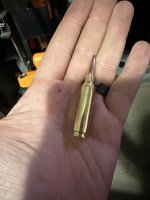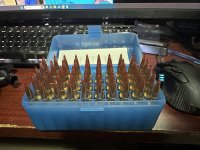DB, that isn't how you measure overall length when you're measuring to correct seating depth, for the distance the bullet has to travel to enter the leade for best accuracy. Maybe you know this?
The tips on bullets are often different lengths, especially lead tip bullets and even the plastic inserts shown in your pic.
You can purchase a "Nut Gauge" which has six different size holes to engage the bullet on the OGIVE where the dimensions should be consistent from one bullet to the next.
If you have the tools, you can use just about any type of material, which is hard enough not to deform or wear quickly, just by drilling a hole large enough to accept the bullet tip to appx half way down onto the ogive.
Measuring the gauge and the cartridge to the base, will give you a consistent length to measure.
The method you show in the pic is great to ensure the loaded round will fit into your rifles magazine.
Click to expand...
DB wrote: I went and bought the Hornady bullet comparator kit, grabbed one of my reloads and then opened my Lyman reloading manual, and I am back to square one... It doesn't list a measurement from the 'ogive', just an OAL. How can I find what the ogive measurement should be for 6.5 Creedmoor rounds?
---------------------------------------------------------------------------
The manual lists the "OVERALL ALL LENGTH" of the cartridge to show what will fit in "most" rifle magazines. That's all it's for.
The measurement I was going on about, on the ogive, is much more important to accuracy.
The OAL is a good place to start.
Rifle chambers are "different" from one model/manufacturer to the next.
Depending on the rifle, bullet seating depth and the distance it has to travel before engaging the leade/lands, while the base of the bullet is still being supported by the case mouth, can be extremely important when it pertains to accuracy.
Some rifles have chambers with very tight tolerances, which can get away with "FREE BORE" and still be accurate. Most don't.
Most recently manufactured rifles from North America, Europe and maybe a few others, now use CNC equipment and tooling with very tight tolerances, resulting in rifles which will even shoot off the shelf, commercial ammo well.
This is a relatively recent phenomena. Not long ago, buying any Nort American offering was hit and miss as far as accuracy potential goes.
Most rifles with generous chamber dimensions shoot best when the bullet base is still being held by the cartridge case mouth when the ogive engages the rifling.
This is all well and good, if your rifle's throat is short enough for this to happen, with the bullets you're shooting.
Manufacturers intentionally make the throats too long, creating a "free bore" situation, where the bullet has to "jump" a gap between the case mouth and the leade before engaging. This tends to cause accuracy issues in rifles with generous chamber dimensions.
Some of this issue can be resolved by fireforming your cases to the individual rifle and "neck sizing" only.
It doesn't solve the problem of a generous throat dimension, which allows propellant gases to escape around the bullet before it enters the leade, and causing very slight bullet "cant" on entry, which creates accuracy issues that are otherwise unexplainable.
The engineers in the past understood this issue and when they disigned their cartridges and chambers, they intentionally made "LONG NECKS" part of the design to alleviate the "jump" issue. Accuracy standards were much less aggressive then.
If the throat dimensions are cut very close to the bullet diameters, free bore becomes less of an issue.
The Europeans, who weren't dogged and curtailed by legalities and liabilities, "fixed" the freebore issue long before North American manufacturers, who mostly went out of business for one reason or another or were recently bought up by European and other off shore companies.
I'm only going to list one off shore manufacturer who caused the "standards" for throat dimensions to be changed in North American manufacturing, TIKKA. There were and are several others.
Most Tikka rifles have long throats and lots of free bore. However, they have tight chamber tolerances which allows the bullet to "jump'' into the leade without cant.
Bench Rest Shooters often seated the bullets in the necks so they would fully engage the leade when the cartridge was chambered, to reduce free bore effects completely. This can only happen when all other tolerances are extremely tight, or it becomes an unsafe condition. This is where fire forming and neck resizing only comes in.
I could go on and on but others can chime in and you need to find out what is required from "your rifle"









































































